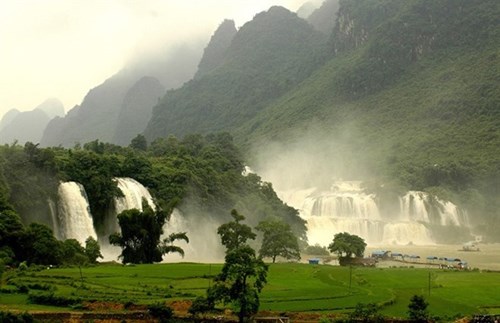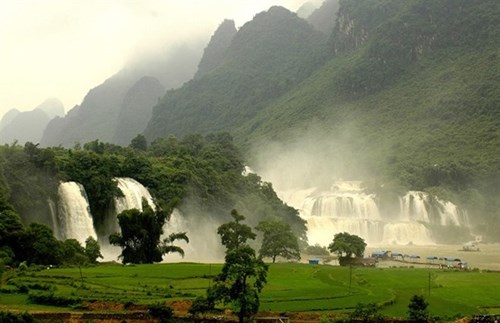
The People’s Committee of Cao Bang province and the Ministry of Construction on August 17 announced master and detailed plans for developing Ban Gioc waterfall tourist site.
The announcement aims to
call for investment from enterprises to turn Ban Gioc waterfall tourist site
into a key tourism site of the northern mountainous province and the nation,
contributing to boosting the development of the province and the region.
Under the master plan,
approved by the Prime Minister in April this year, the Ban Gioc waterfall
tourist site will cover 1,000ha while the central area of the site will cover
156.7ha.

Ban Gioc Waterfall
Facilities will be also built in the zone to serve tourism,
including hotels and service areas.
The tourist site is
expected to welcome approximately 750,000 visitors per year and have more than
1,000 rooms for tourists by 2020. By 2030, the tourist site is estimated to
receive 1.2 million visitors and have some 1,750 rooms for visitors.
The central area of the
Ban Gioc waterfall tourist site is set to have four areas including the Ban
Gioc waterfall landscape, the landscape along the Quay Son River, the
mountainous forestry landscape ecology and the agricultural landscape ecology.
Ban Gioc is in Dam Thuy
commune, Trung Khanh district, on the border with China’s Guangxi province. It
is
53 metreshigh and
300 metreswide and has three levels of smaller waterfalls.
The waterfall is the
fourth largest border waterfall in the world and was named one of the ten most
spectacular waterfalls in the world by travel site Touropia.
In 2016, the tourism site
welcomed more than 178,000 visitors.
Source: PANO
Located just a 20-minute drive from Hoa Binh City, Ora Hill Farmstay & Glamping Hoa Binh is a captivating new destination nestled in Mo hamlet, Bình Thanh commune, Cao Phong district. Combining farming with leisure, this tranquil retreat is perfect for those seeking balance, joy, and an immersive experience in the expansive beauty of nature.
Muong Bi - Tan Lac is renowned as one of the four famous Muong regions in Hoa Binh province. Blessed by nature with a favourable climate and stunning landscapes, Tan Lac holds great advantages for tourism development. The local tourism industry has made remarkable strides in recent times thanks to the attention and support from the local authorities and sectors.
With its strategic location, well-developed transport network, and diverse soil and climatic conditions, Hoa Binh is emerging as a must-visit destination in Vietnam's northwestern tourism corridor. The province boasts numerous attractions, including the Kim Boi hot springs (Kim Boi district), the Dau Rong cave complex (Cao Phong), the Mai Chau valley (Mai Chau), and the iconic Hoa Binh hydropower plant.
The northern mountainous province of Hoa Binh has been listed among the 71 most beautiful places to visit worldwide by the prestigious US travel magazine Condé Nast Traveller.
Hoa Binh province’s rich natural and cultural resources position it as a prime location for developing community-based tourism (CBT). In recent years, support from central and provincial policies, as well as assistance from non-governmental organisations, have encouraged local ethnic minority and mountainous communities to actively engage in the sector.



